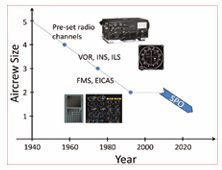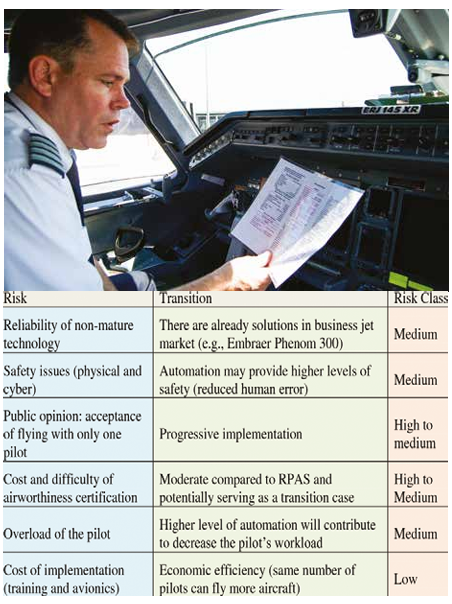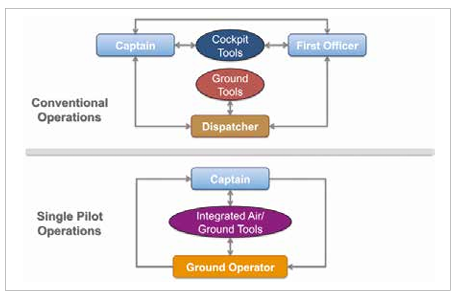
Single Pilot Operations
Single-pilot aircraft are not only about cost advantages they also serve as a powerful driving force for the development of next-generation, human-centered aviation technologies. However, this transformation is just as much about human factors, passenger confidence, and organizational structures as it is about technology.
The development of single pilot flight decks will provide the economic and operational impetus for the development of a range of advanced technologies for implementation in the next generations of commercial aircraft, irrespective of how many crew are ultimately on board. In a single crew airliner, increased levels of sophisticated automation and/or autonomy will be necessary to reduce the demands on the pilot in times of high workload or to ultimately take control of the aircraft in the case of pilot incapacitation. To do this there needs to be the appropriate allocation of work between the pilot and the aircraft to ensure safe and efficient flight. Single crew aircraft flight decks will provide a catalyst for the development of a new range of human-centred technologies supporting new airline operational concepts. The human factors requirements will likely be the prime driver, not the hardware and software technologies.
The trend in flight deck design over the past half century has been one of progressive ‘de-crewing’ . The common flight deck complement is now that of two pilots, but only 50 years ago, it was common for there to be five crew on the flight deck of an airliner. Now, just two pilots, with much increased levels of assistance from the aircraft, accomplish the same task. However, at the moment, by regulation and by law, two pilots is the current minimum flight crew complement for a large commercial aircraft. Nevertheless, there are signs that this may change in the future. In 2018 as part of the ‘FAA Reauthorization Act of 2018’ put in front of the US Congress, it was proposed that the ‘Administrator shall transmit a report to the Committee on Science, Space, and Technology of the House of Representatives and the Committee on Commerce, Science, and Transportation of the Senate that describes… a review of FAA research and development activities in support of single-piloted cargo aircraft assisted with remote piloting and computer piloting’. Such a change in legislation would clear the way for the introduction of a FAR/CS part 25 single pilot passenger aircraft, but initially in cargo operations

Originally the main driver for single pilot operations was financial, but issues relating to a potential shortage of commercial pilots in the near future now play a major part. The air transport industry struggles with profitability, with constant downward demands on pricing and unpredictable, fluctuating fuel costs. The IATA (International Air Transport Association) report for the second half of 2016 shows that the average return fare in 2017 (before surcharges and tax) was $351, down from $407 in 2015, and it was actually 68% lower than in 1995. World-wide post tax profits have declined from $9.89 (per passenger) in 2015, to $7.546. Airline personnel costs vary between about 11% of operating costs to nearly 25%, depending upon aircraft type, sector length and how much activity is outsourced: the crew themselves can represent up to 13% of operating costs (excluding fuel and propulsion). Halving the number of pilots has the potential to produce significant cost savings, especially in smaller regional aircraft operated on shorter, ‘thinner’ routes which may not be economically viable with higher capacity airliners. The direct operating costs attributable to flight deck crew rise as aircraft size decreases. It is estimated that for an airliner with two pilots and three cabin crew, the flight deck represents 67% of crew costs; this rises to around 76% in an aircraft with fewer than 100 seats which requires only two cabin crew.

The challenges for this type of aircraft are essentially the same as those for any aeroplane carrying passengers. It must be at least as safe as the equivalent existing multi-crew aircraft but from a pilot perspective it must also be more error tolerant. It must not impose higher levels of workload on its single pilot than those in the equivalent multi-crew aircraft, but it must promote the same level of pilot understanding and awareness of issues such as the airspace picture, tactical and strategic flight planning, aircraft system awareness and the flight envelope. It must be capable of operating in all categories of airspace and at all airports without requiring special assistance from Air Traffic Control (ATC). Many aspects of the current ATC-Air-pilot operational relationship are predicated on a two-person flight deck: single pilot types often require special handling to avoid overloading the crewmember with lengthy RT exchanges. However, SESAR, NEXTGEN and similar initiatives which will support increased connectivity have the potential to aid single pilot operations in the future in this respect via the use of non-voice ATC communication. From an airline’s perspective its overall operating costs must ultimately be lower than that of a multi-crew aircraft. This includes acquisition, training, maintenance and operational support. Initial costs during the introduction of the technology may be increased but to be a viable proposition, these must ultimately be reduced. It is not just about the technology required to build the aircraft, it is about operating it. However, the biggest challenge may have nothing to do with piloting the aircraft or the safety of its technology. Referring to pilotless commercial aircraft, John Hansman, Professor of Aeronautics and Astronautics at the Massachusetts Institute of Technology commented ‘the issue has never been ‘Could you automate an airplane and fly it autonomously?’ The issue is “‘Could you put paying customers in the back of that airplane?’” The same basic question applies to single crew aircraft: will people pay to fly in it? Recent research on passenger opinion emerging from the USA has produce a resounding ‘maybe…”
Various technological approaches are being explored for the development of a single pilot aircraft. Some focus upon the development of much increased levels of automation (for example, intelligent knowledge-based systems, autonomous systems and adaptive automation). Other approaches adopt a more technologically-cautious approach to using a large amount of on-board computing. These use a distributed systems-based design philosophy, utilising a great deal of extant technology derived from single seater military aircraft and UAS (Uninhabited Aviation Systems) technology. It would be inappropriate to characterise these approaches as ‘either/or’ options: there is a great deal of commonality in the technologies to be developed and the operational challenges that airline operators would face. However, it is useful to characterise the approaches to developing a single crew aircraft in this way to illustrate the unique advantages and challenges faced by each technological strategy.

Autonomous Systems Approach
Early approaches to the development of a single crew aircraft mostly utilised onboard technology: the emphasis was on adaptive automation and decision aids in the form of ‘intelligent co-pilots’ or ‘cockpit assistants’ . Most of these systems were developed from military programmes where the pilots experienced an array of threats and were under periods of extremely high workload. These systems typically monitored the actions of the pilot comparing them against data from the position of the aeroplane, status of the onboard systems and external environmental factors. Algorithms were employed to determine if there was any difference between the expected and actual states.
The distributed crewing design approach utilises a great deal of extant technology. This design philosophy has been adopted by the UK Future Flight Deck and Open Flight Deck programmes and by NASA in the US for its single crew commercial aircraft concept. This concept regards the single crew aircraft as one part of a wider system consisting of several elements, comprising the aircraft itself (including pilot), and a ground-based component including a ‘Second Pilot’/’Ground Pilot’ support station (or a ‘Super Dispatcher’ in the NASA concept16); real-time engineering support and navigation/flight planning support facility. In this type of system, the co-pilot is not replaced by on-board automation or autonomy, they are displaced.
The Role of the Human
The common theme between automated and autonomous systems is the need for the human to set the high-level goals and to monitor the system. It is a misconception, not helped by terms such as, ‘unmanned’, that there is no human involvement required. The modern flight deck, while possessing a high degree of automation, still requires a large degree of supervision and monitoring from the flight crew, and the pilots need to be able to intervene when external factors require changes to the initial plan for the flight. The same will be true of the single pilot airliner, irrespective of how the technology is implemented. Even in systems with a lesser or greater degree of autonomy it is important to recognise that the role of the human is not only critical in terms of supervising the system, but also providing key inputs that improve the system outcome. The caveat here is that the automation and/or autonomy should be built around what the human is bad at (for example, tasks that require long periods of vigilance, mental fatigue, mental overload) and also what the human is good at (for example, tactical decision making) – not just the former.
Operational and Organisational Considerations
In addition to the technological, economic, regulatory and the societal acceptance of the single pilot concept there is one further major issue to address: the organisational aspects of the operation of such an aircraft in airline service. Removing one of the pilots has ramifications across a wide range of organisational areas. Taking a human-system integration approach, such redistribution of tasks raises substantial issues in areas such as manpower, personnel selection and training. For example, a key manpower question is how many people will be required on the ground to support the pilots in the air (in either aircraft configuration)? A number of personnel selection issues arise. In the current system, pilots initially train and qualify as co-pilots. They become eligible for selection and training as captains only after they are deemed to have gained sufficient experience in the co-pilot role. As the co-pilot role ceases to exist in a single pilot concept, the question arises concerning how single pilots would gain the necessary experience to operate safely as Captain and how they would be trained? All pilots would effectively have to be Captains. An aircraft commander is not just responsible for flying the aircraft but also for making sound safety decisions concerning operations, crew management and passenger situations. The question also arises as to what experience and qualifications would be required for ground-based personnel and whether they need to be recruited from outside the existing airline resource pool?

A Design Challenge
The single crew airliner is still probably 20 years away, however with the legislative developments in the USA it is possible that the single pilot cargo aircraft may be closer to becoming a reality. This will invariably pave the way for single crew airline operations and provide the opportunity to develop the technology required. Whether or not single pilot operations ever enter commercial service, as a design exercise the single pilot aircraft will provide the opportunity for a re-appraisal of the pilot’s tasks on the flight deck, taking a truly human-centred approach. It will almost inevitably derive new pilot-support requirements for development by the avionics companies which will be applicable for single and multi-crew aircraft. It will provide a test bed for new approaches to safety, certification and design processes, and help to address options for the safe recovery of an aircraft in the case of pilot incapacitation. And far from decreasing the need for pilots it may actually increase the need. Parimal Kopardekar, Project Manager for the Concepts and Technology Development Project at NASA Ames Research Center, noted that single pilot operations are ‘a polarizing topic20. He suggested that if single crew operations could be implemented the cost per passenger, per mile would decrease and as a result ticket prices would concomitantly fall which would result in an increase in demand, potentially requiring more pilots and more aircraft.

The key drivers for further reductions of flight deck crew in commercial operations will likely come from sources other than technology (costs, demographics, demand and crew availability).
The move towards more-automated or autonomous cockpits will be an opportunity to further increase aviation safety and support new developments in key areas of cockpit technologies.
The effort required to enable this must not be underestimated and the temptation to consider in any way the possibility of replacing further crew without a full redesign of the cockpit flight control systems should be avoided.